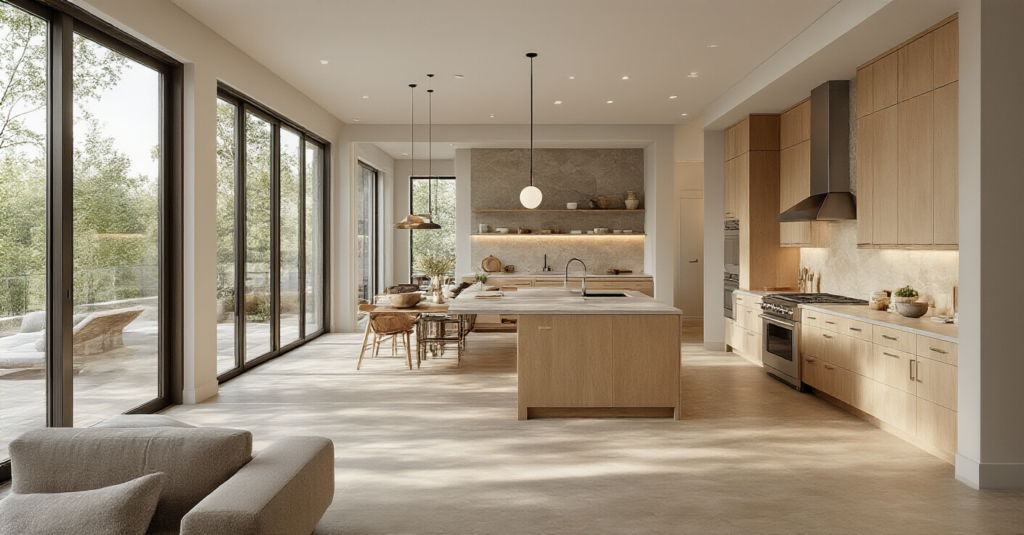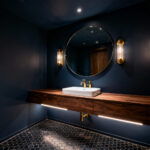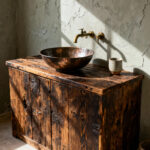Can we talk for a minute about why so many “contemporary” kitchens get it so wrong? You’ve seen them online. All stark white, sharp angles, and so minimalist they look like no one actually lives there. They’re beautiful in a picture, but they often feel cold, sterile, and just… soulless. My biggest pet peeve is when design forgets about the people who have to live in the space. A kitchen is the heart of your home; it’s where you nourish your body and connect with your family. It should feel supportive and calming, not like you’re in a science lab.
The real secret to a stunning contemporary kitchen isn’t just about flat-panel cabinets and integrated appliances, though we’ll get to that. It’s about creating a space that actively supports your physical and mental well-being. It’s about blending that clean, modern aesthetic with principles of wellness architecture—thinking about how the light, air, materials, and flow impact your health and happiness. Forget the corporate speak and the trend-chasing. This is what actually matters, and I’m going to give you the shortcuts I wish I’d known when I first started.
Laying the Foundation: Vision & Layout (Part 1)
Alright, before you even think about countertop materials or faucet styles, we need to talk about the bones of the space. So much of how a room feels is determined before a single cabinet is installed. This part is about getting the fundamental flow and energy right. It’s less about decoration and more about the deep, intuitive sense of well-being you want to feel every time you walk in.
1. Prioritize Open-Concept Integration for Flow
You hear “open concept” and probably think about resale value, but let’s talk about what it actually does for your daily life. It’s not about just knocking down walls; it’s about creating connection. When the kitchen flows into the living area, the person cooking is no longer isolated. You can chat with your partner while they’re on the sofa, help kids with homework at the dining table, and engage with guests during a party. This social connection is a huge, and often overlooked, pillar of mental well-being. It dissolves the barrier between chores and life.
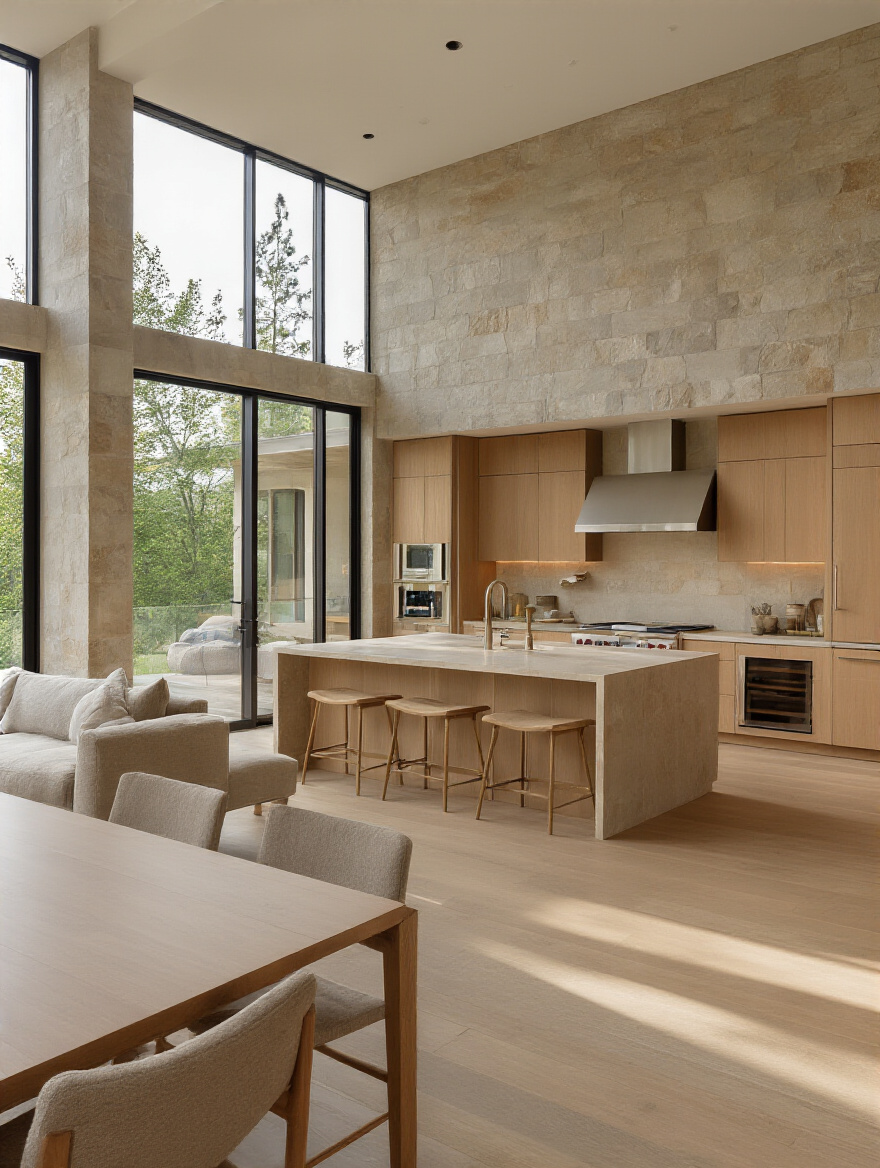
I had a client, a young mom, who felt a huge sense of loneliness preparing meals while her family was in the other room. By removing a non-structural wall, we didn’t just make the space feel bigger; we changed the entire dynamic of their evening routine. The BS everyone tells you is that it’s all about sightlines. The truth is, it’s about shared experiences. And from a wellness perspective, sharing the natural light from multiple rooms floods the space, which helps regulate everyone’s internal clocks, or circadian rhythms, leading to better energy during the day and better sleep at night.
And now that we’re talking about shared spaces, let’s nail down what that aesthetic should actually feel like. It’s about finding calm, not just being ‘minimal’.
2. Define Your Contemporary Aesthetic: Minimalism Meets Function
Okay, “minimalism.” This word gets so misused. True wellness-focused minimalism isn’t about having nothing; it’s about having only what is necessary and beautiful. It’s a design approach that directly combats decision fatigue and the low-grade anxiety that comes from clutter. Think about it: a visually chaotic environment creates a mentally chaotic one. Our brains are constantly processing our surroundings, and when surfaces are covered in stuff, it keeps our nervous systems on a low simmer of alert. That’s the opposite of what a home should feel like.
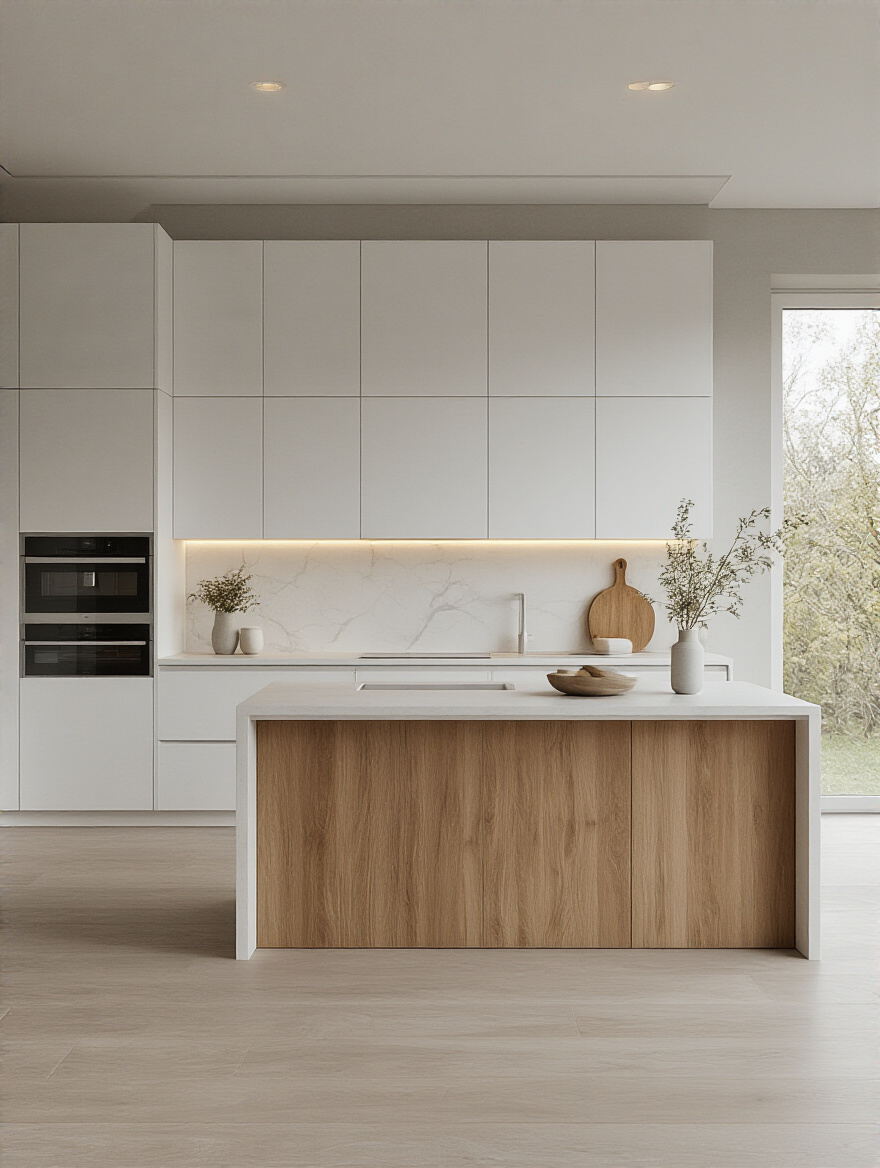
The shortcut here is to think of it as “intentionalism.” Every single object on your counter should either be beautiful or incredibly useful—ideally both. I once had a client who was so stressed she couldn’t figure out why. We went into her kitchen and there were dozens of little gadgets, mail, and tchotchkes out. We spent a day creating a home for everything, hiding the non-essentials. The very next week, she told me she felt like she could breathe in her own house for the first time. The goal isn’t an empty room; it’s a calm mind.
Of course, a calm mind is much easier to achieve when your body isn’t stressed out just trying to make a sandwich. That’s where the layout comes in.
3. Optimize Layout for Ergonomic Work Triangles
You’ve probably heard of the work triangle—the path between your fridge, sink, and stove. What people get wrong is thinking it’s just some rigid, old-fashioned rule. But this is ergonomics 101, and ergonomics is all about wellness. It’s about designing a space that fits the human body, reducing physical strain and unnecessary effort. When your layout is optimized, you aren’t walking a marathon just to make spaghetti. You pivot. You flow. The whole process becomes more intuitive and less physically taxing.
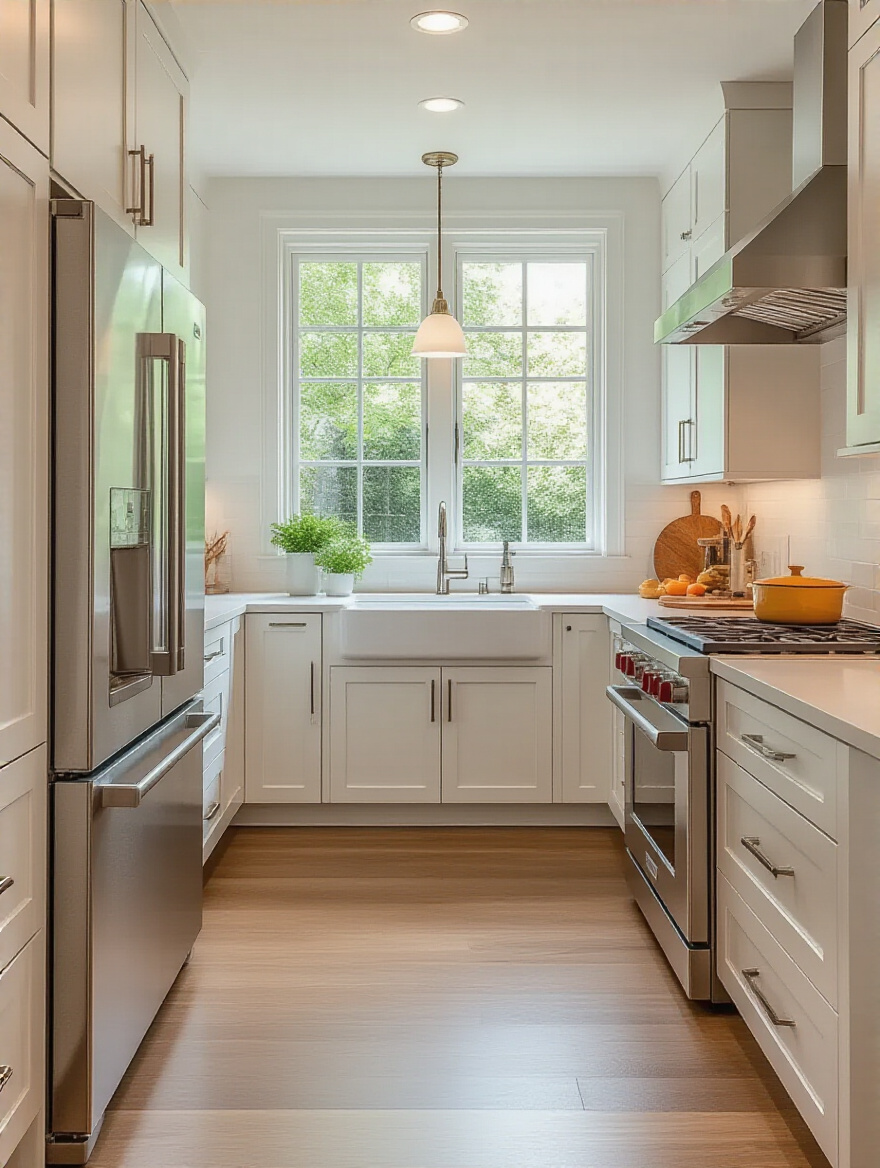
A well-designed work triangle (or work zones in bigger kitchens) means less bending, less twisting, and less stress on your back and joints over time. It transforms cooking from a frantic chore into a graceful, mindful practice. I learned this the hard way in my own first apartment kitchen. The fridge was on the opposite side of a doorway from the stove. I was constantly running back and forth, exhausted and irritated by the time dinner was ready. Don’t let your layout dictate your mood. Think about your movements first, and design the kitchen to support them.
The single most important source of energy for this new flow? It doesn’t come from a plug. It comes from the sun.
4. Assess Natural Light Potential and Enhancement
This one is non-negotiable for me, and it goes so much deeper than just making a room look pretty. Natural light is a nutrient. Our bodies need it to produce Vitamin D, to regulate our sleep-wake cycles, and to boost serotonin, which elevates our mood. A dark, artificially lit kitchen can literally make you feel tired and depressed. Before you do anything else, assess how you can maximize sunlight. Are there bigger windows you could install? A skylight? Can you replace a solid back door with one that has glass panels?
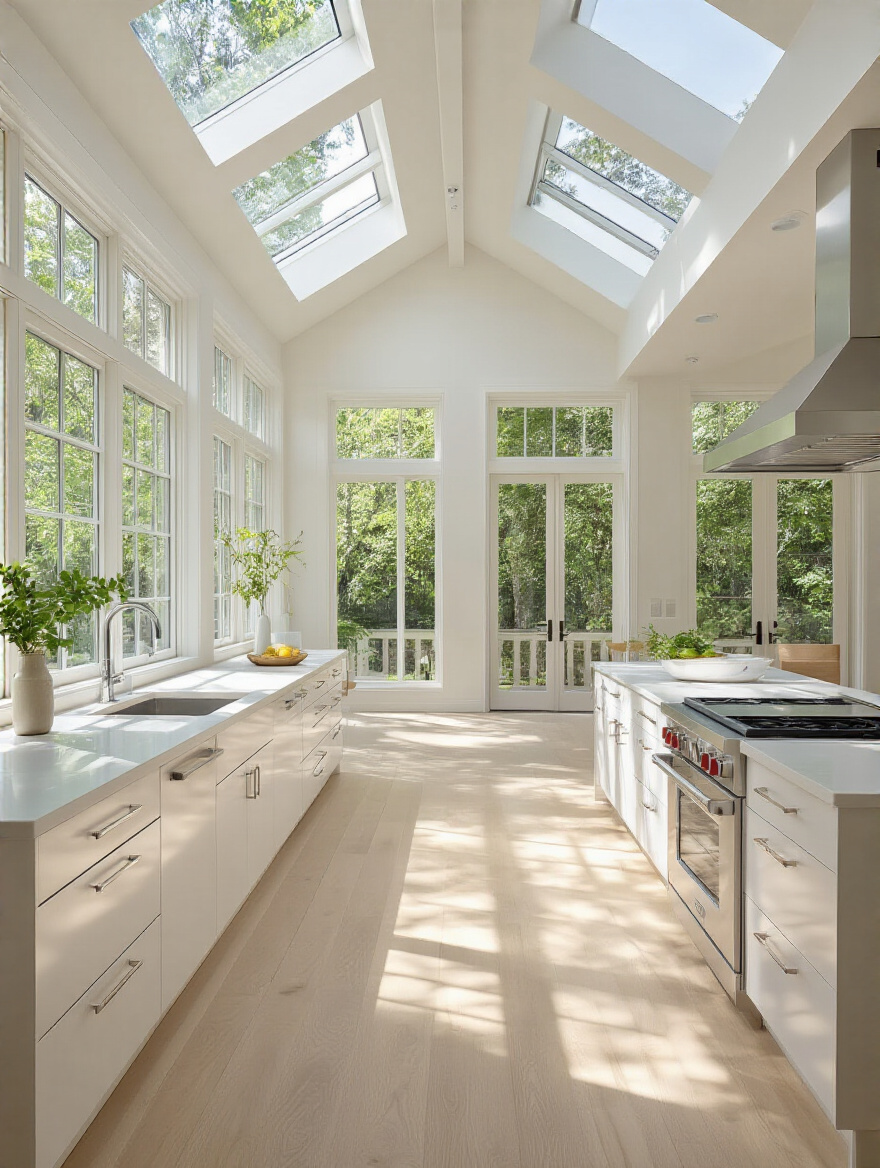
I once worked on a narrow townhouse kitchen that was perpetually dark. The clients thought they just needed better light bulbs. Instead, we installed a “light tube,” a simple tubular skylight that funneled sunlight down from the roof into the center of the room. It was transformative. The room felt bigger, yes, but more importantly, my client said her energy levels in the afternoon completely changed. Don’t just paint a room white and hope for the best. Actively pull in the light. It’s the most powerful and freely available tool for making a space feel alive.
So we’ve established the bigger picture of the layout, but the next step is planning for all the stuff you’ll actually use within that beautiful, light-filled space.
5. Incorporate Smart Storage Solutions from the Start
Here’s where a lot of projects go off the rails. People design a beautiful, minimalist kitchen and then realize they have nowhere to put their blender, their air fryer, or the mountain of Tupperware. Smart storage isn’t an add-on; it’s the engine that makes minimalism possible. This needs to be planned from the very beginning. Think full-height pantry pull-outs, deep drawers with dividers for pots and pans, and hidden “appliance garages” that keep your countertops clear.
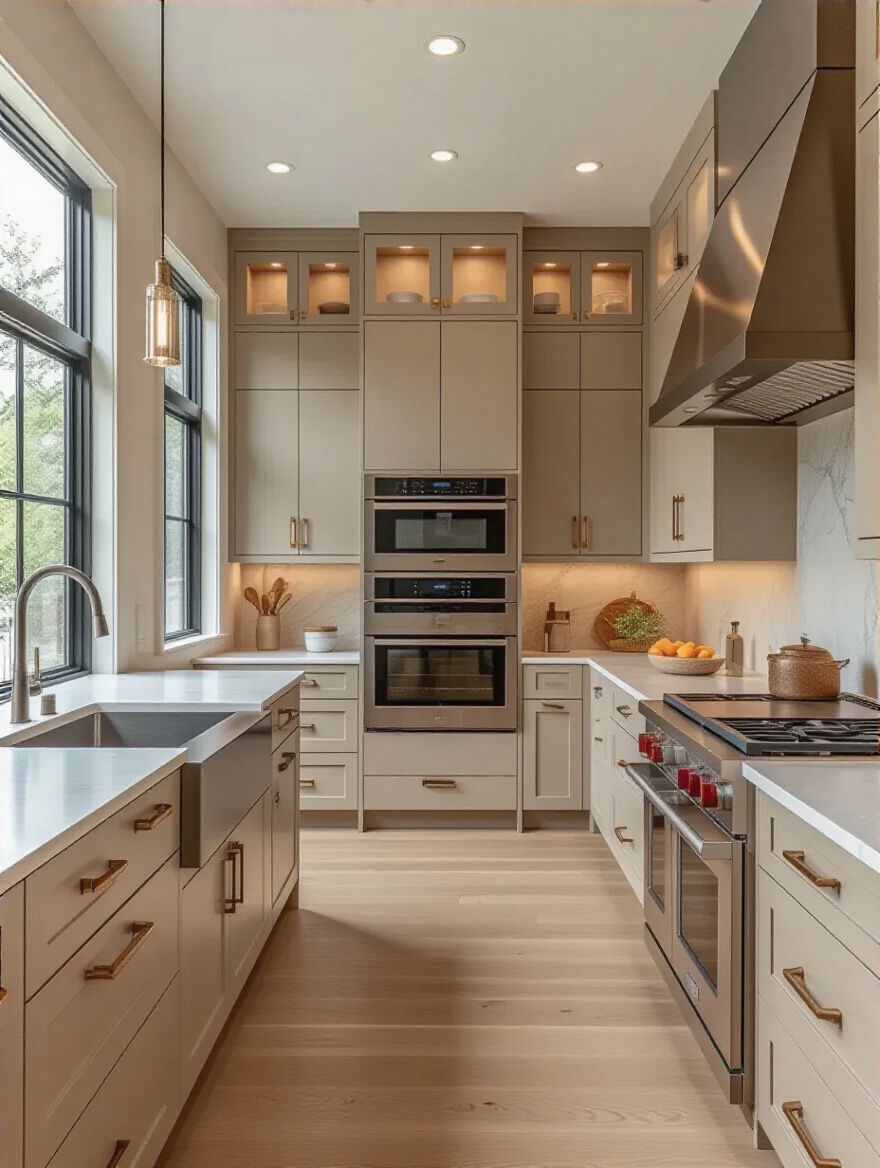
This is a mental health strategy disguised as cabinet design. Every time you open a drawer and can’t find what you need, it’s a tiny spike of cortisol—a little stress response. But when you open a drawer and everything has its place, it’s a moment of calm. That feeling, compounded over hundreds of interactions a month, genuinely lowers your overall stress level. My shortcut for clients is this: before you design your cabinets, empty out your entire current kitchen onto the floor. It’s a pain, I know. But seeing everything you own in one place is the only way to truly plan for a home for all of it.
Crafting the Modern Core: Materials & Fixtures (Part 1)
Okay, now that the foundation is solid, we can get into the tangible things—the surfaces you touch, the fixtures you use every day. These are the elements that define the look, sure, but more importantly, they define the experience of your kitchen. And my philosophy is that every material and fixture should not only be beautiful but also durable and healthy.
6. Select Flat-Panel Cabinetry for Seamless Lines
Everyone thinks flat-panel (or “slab”) cabinets are purely an aesthetic choice for a modern look. And they are sleek and beautiful. But the wellness secret behind them? They are incredibly easy to clean. Traditional cabinets with all their trim and detailing have dozens of little crevices where grease, dust, and food particles accumulate. That’s not just a cleaning headache; it’s a haven for allergens and bacteria.
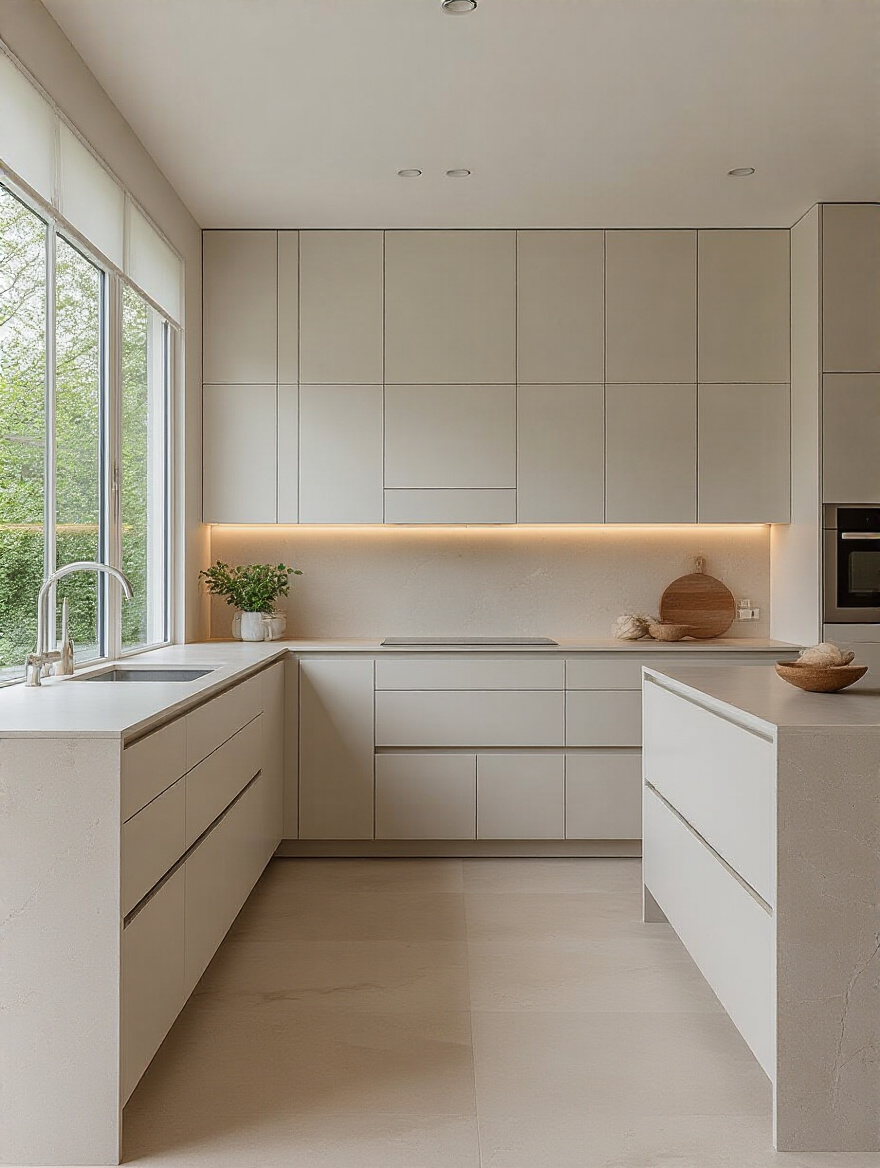
With flat-panel cabinetry, you have a smooth, unbroken surface that you can wipe down in seconds. This contributes to better indoor air quality and a more hygienic environment with less effort. For a truly seamless look that’s also great for wellness, opt for handleless designs with integrated channels or push-to-open mechanisms. Fewer handles mean fewer surfaces to grab with messy hands, reducing the spread of germs. It’s a small detail that makes a big difference in the health and feel of your space.
Now, let’s talk about the surface that takes the most abuse and has the biggest impact on your kitchen’s health: your countertops.
7. Choose Durable, Low-Maintenance Countertops (Quartz, Concrete)
Your countertop is the hardest-working surface in your home. The key here is to choose materials that won’t add to your stress load. For this, quartz is one of my top recommendations. It’s an engineered stone, which means it’s non-porous. In plain English: it won’t absorb liquids, so you don’t have to worry about it staining from spilled wine or coffee. More importantly, being non-porous means bacteria and viruses have nowhere to hide, making it an incredibly hygienic surface for food prep.
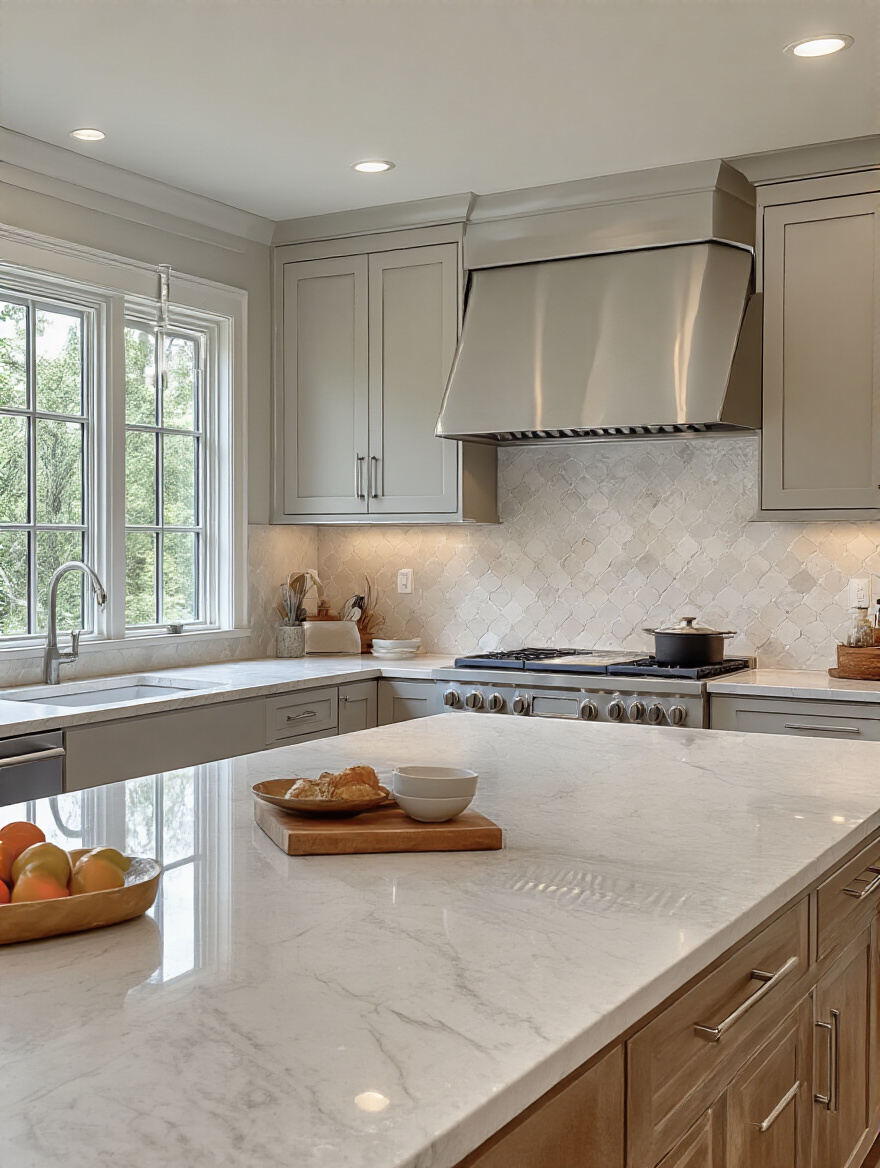
The original article mentions concrete, and while it can look amazing, I have to call out some BS here. Standard concrete is porous. You have to be diligent about sealing it correctly and often, or it will stain and can harbor bacteria. So if you go that route, know the maintenance commitment. Another fantastic, often-overlooked material is a solid surface like Corian. It’s also non-porous and can be installed with seamless joints, meaning no gross grout lines between your counter and backsplash. The goal is a surface that is tough, healthy, and forgiving—so a dropped glass or a forgotten spill isn’t a catastrophe.
After the countertops, the next workhorses of your kitchen are the appliances, and their impact goes far beyond just cooking your food.
8. Install Energy-Efficient, Integrated Appliances
This is about more than just a sleek look and a lower energy bill, though both are great benefits. Choosing the right appliances is a critical wellness decision. My top shortcut here is to prioritize an induction cooktop over gas. So many people love cooking with gas, but the reality is that gas stoves release nitrogen dioxide, carbon monoxide, and formaldehyde into your home’s air, which can have significant respiratory impacts, especially for kids. It’s one of the biggest sources of indoor air pollution.
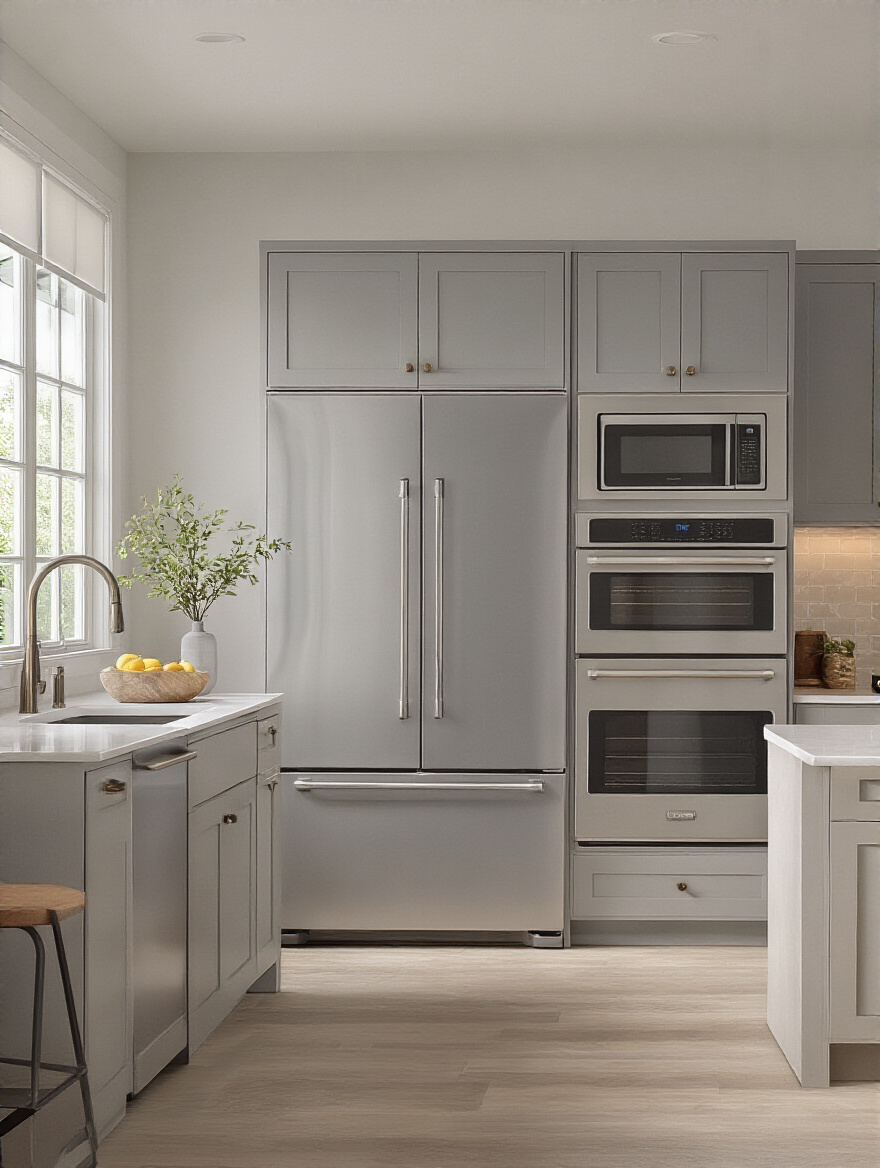
Induction, on the other hand, is electric, heats up incredibly fast and precisely, and produces zero emissions inside your home. It’s safer, healthier, and the flat glass surface is a breeze to clean. When you do select your appliances, getting them panel-ready so they can be hidden behind cabinetry isn’t just an aesthetic trick. It creates a calmer visual plane, which, as we discussed, contributes to a less cluttered mental state. It’s about designing a space that’s calm and healthy, inside and out.
The appliance you interact with most frequently, however, is probably your faucet. Let’s make sure it’s working for you, not against you.
9. Integrate Smart Faucets with Sleek, Minimalist Design
I used to think smart faucets were a gimmick. A total waste of money. Then I got one, and I realized its biggest benefit isn’t the “wow” factor; it’s hygiene. Think about how many times you’ve touched the faucet handle after handling raw chicken or eggs. A touchless faucet eliminates that cross-contamination point entirely. You can turn the water on and off with a wave of your hand, keeping the fixture and your kitchen cleaner and safer.
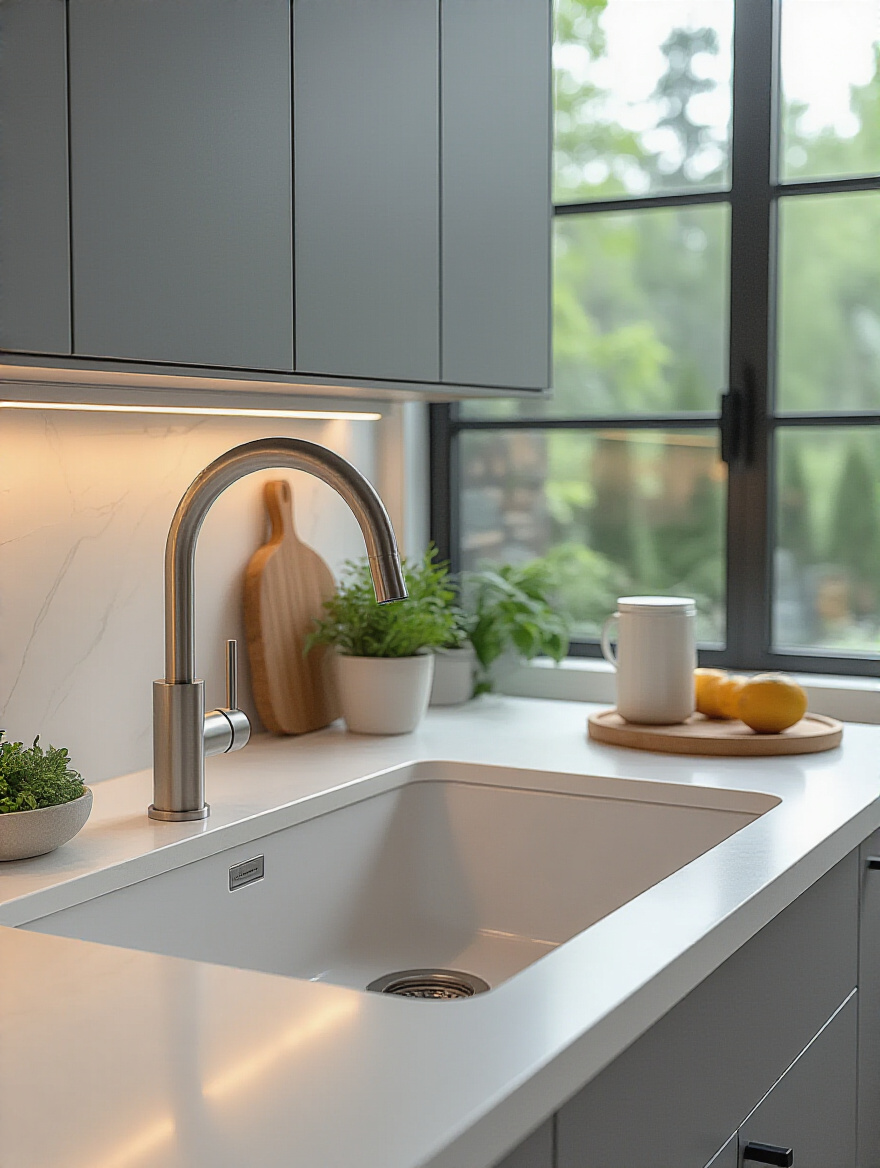
That alone makes it a worthwhile investment from a wellness perspective. Beyond that, many smart faucets can dispense a precise amount of water, which helps with conservation, or show you the water temperature with a colored LED light, preventing accidental burns. So forget the tech-for-tech’s-sake noise. The real reason to get a smart faucet is for a healthier, safer, and more mindful interaction with water every single day.
Finally, let’s look at the literal foundation of the room. It’s something we walk all over, but rarely think about from a wellness perspective.
10. Opt for Large-Format Tile or Polished Concrete Flooring
Your kitchen floor should be durable, of course, but it should also contribute to a healthy environment. My go-to recommendation is large-format porcelain tile. Why large? Fewer grout lines. Grout is porous and notorious for trapping dirt, mildew, and grime. The fewer lines you have, the easier your floor is to keep truly, deeply clean, which is a major win for air quality and allergen reduction.
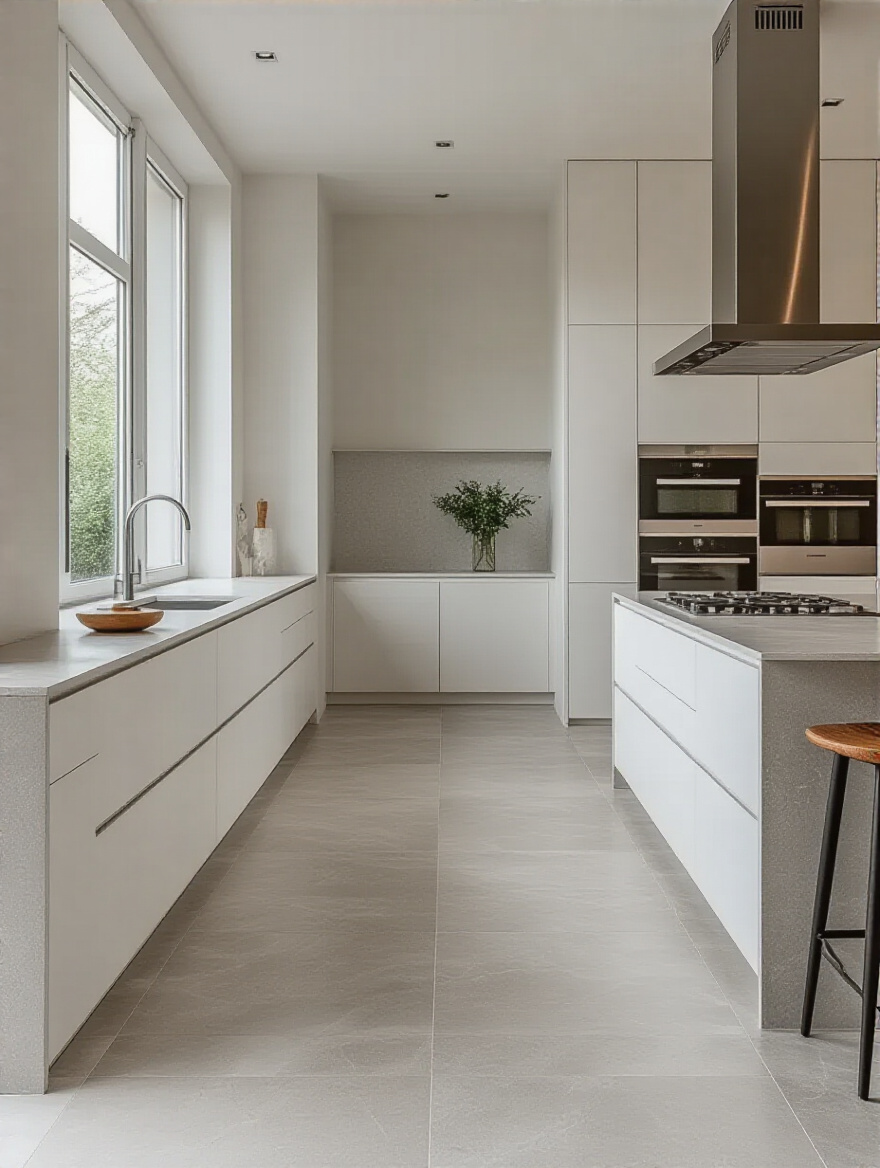
And if you choose something like polished concrete, remember my warning from the countertop section: it needs a high-quality, low-VOC (volatile organic compound) sealer to be non-porous and hygienic. The real pro tip here, and one I wish I’d known earlier, is to consider installing radiant heating underneath your tile or concrete floor. These materials can feel cold and hard underfoot, but adding radiant heat creates a gentle, luxurious warmth that makes the space infinitely more comfortable, especially on chilly mornings. It turns a practical surface into a truly nurturing one.
Elevating Aesthetics: Lighting, Accents & Tech (Part 1)
This is the fun part. We have the solid, healthy core of your kitchen established. Now, we get to layer on the elements that add personality, beauty, and next-level functionality. This is where we fine-tune the feeling of the space, turning it from a functional room into your favorite room.
11. Implement Layered Lighting with Dimmers and Task Fixtures
If there is one thing that will make or break your kitchen, it’s the lighting. And no, one single fixture in the middle of the ceiling is not going to cut it. That’s a surefire way to create a shadowy, straining environment. The concept of “layered lighting” is essential for wellness. You need at least three layers: Ambient (the overall light, like recessed cans), Task (focused light for work areas, like under-cabinet LEDs), and Accent (light that highlights features, like a pendant over an island).

But the most important part of this is dimmers. All of them. On everything. This allows you to tune your kitchen’s light to support your body’s natural circadian rhythm. During the day, you can have brighter, cooler-toned light to promote alertness and energy. As evening approaches, you dim everything down to a soft, warm glow. This signals to your brain that it’s time to wind down and produce melatonin, leading to better sleep. The BS is that lighting is for “mood.” The truth is, it’s a critical tool for regulating your body’s internal clock.
The unsung hero of that layered lighting plan is the one that directly impacts your ability to work safely and efficiently.
12. Integrate Under-Cabinet and Toe-Kick LED Strip Lighting
Under-cabinet lighting isn’t a luxury; it’s a necessity for function and safety. Your ceiling lights, no matter how bright, will always cast a shadow on the counter right where you’re chopping and prepping. Under-cabinet LEDs illuminate that space directly, eliminating shadows, reducing eye strain, and making your tasks safer and easier. It’s a simple change with a massive impact on daily usability.
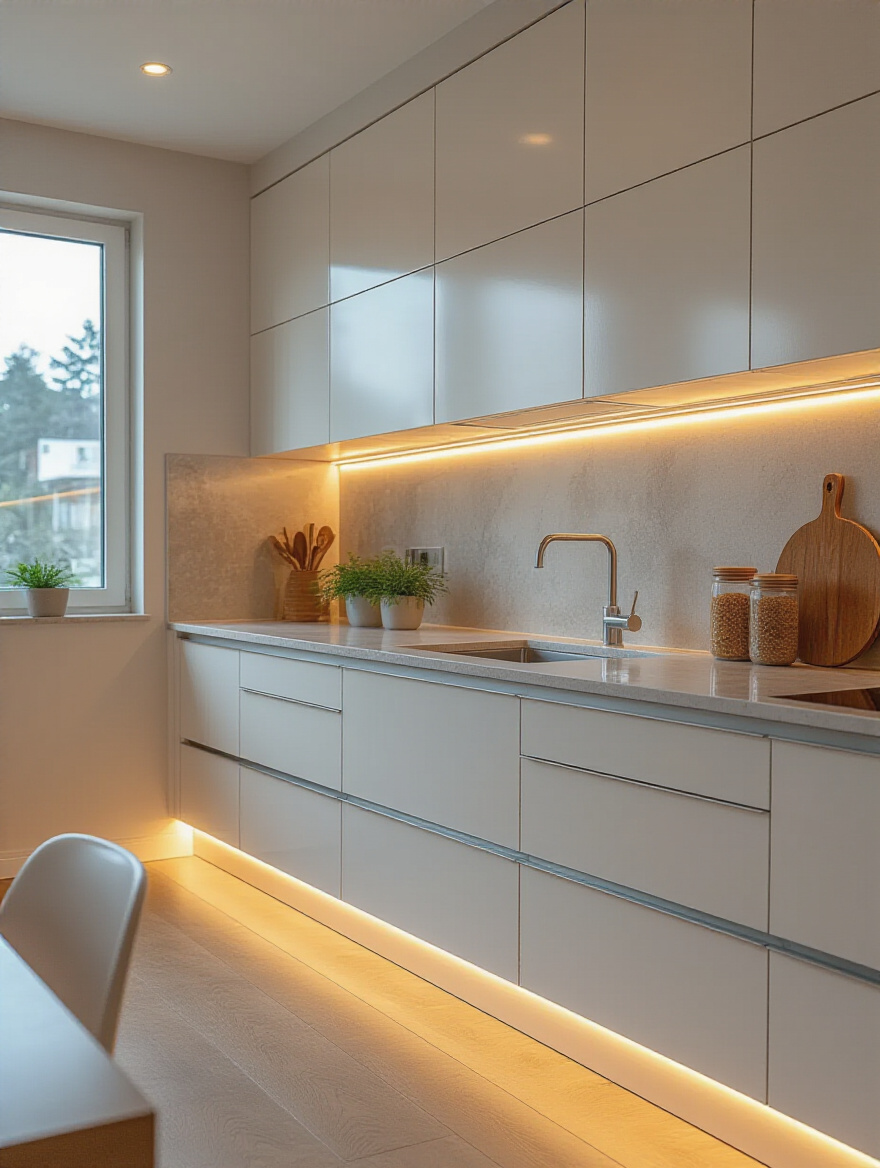
Toe-kick lighting, on the other hand, is a brilliant wellness feature that’s often seen as purely aesthetic. Those soft strips of light at the base of your cabinets are the perfect night-light. They provide just enough illumination for a late-night trip to the kitchen for a glass of water without you having to turn on the jarring overhead lights. This protects your night vision and, more importantly, doesn’t blast your brain with bright light that can disrupt your sleep cycle. It’s gentle, safe, and incredibly smart design.
While toe-kicks provide a subtle glow, there’s always room for a little drama—done the right way.
13. Curate Statement Lighting Over Islands or Dining Areas
This is your moment to add a piece of art that also happens to light up. A beautiful statement fixture over an island or a dining table creates a focal point and anchors the space. It’s an opportunity to inject personality, texture, and soul into a functional room. From a wellness perspective, being surrounded by beauty that you’ve intentionally chosen brings a sense of joy and contentment. Don’t underestimate the power of having one truly stunning element in your kitchen that just makes you happy every time you see it.
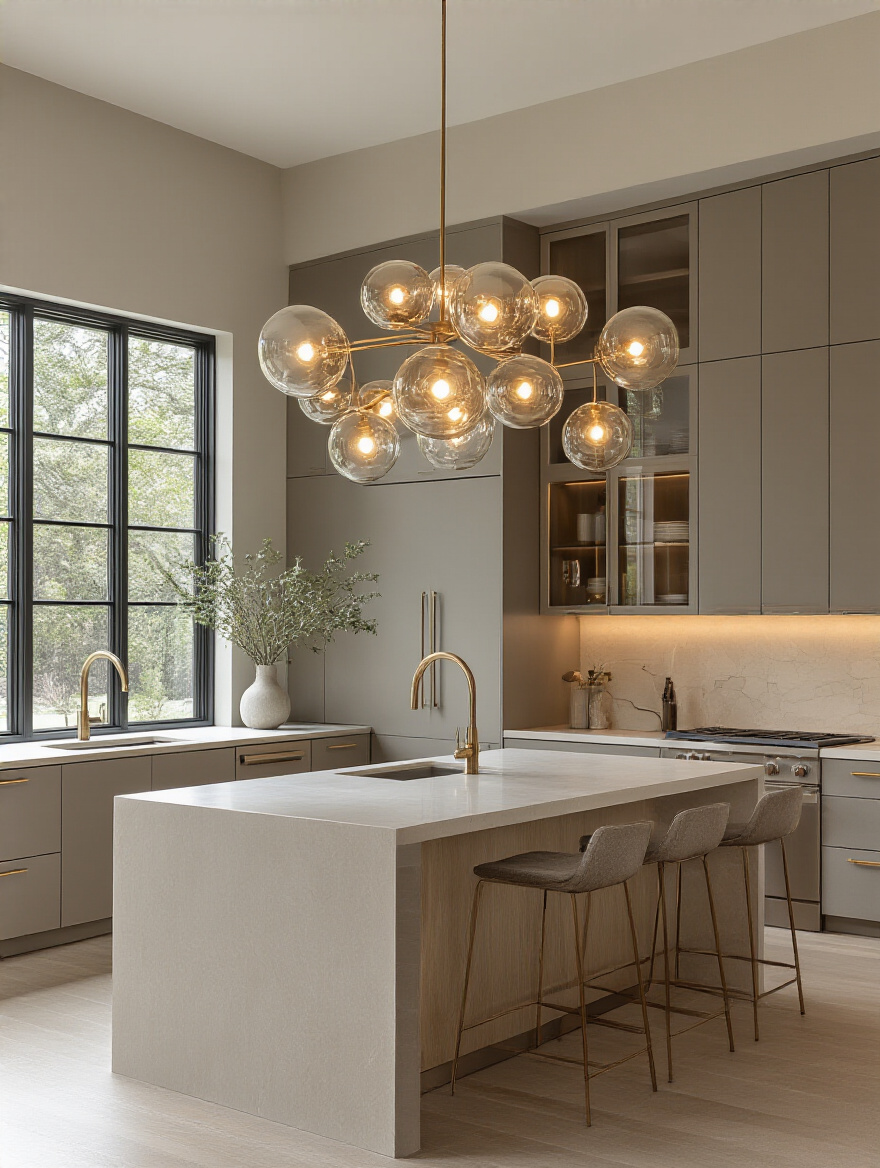
The mistake people make is choosing something based only on looks without considering the quality of light it produces. Does it cast a harsh glare? Is it bright enough for tasks if it’s over an island? Is it dimmable? Always think function first, then find the most beautiful form that achieves it. The shortcut is to look for fixtures with a diffuser or shaded bulbs to provide a soft, even light rather than a harsh, exposed bulb.
Now let’s get into the technology that can either add to our stress or, if we’re smart about it, seriously reduce it.
14. Add Smart Home Tech for Convenience and Control
Look, smart home tech can get out of hand fast. The goal isn’t to have a kitchen that talks to you all day. It’s about using technology to reduce your cognitive load—to automate the little things so your brain has less to worry about. Think about a smart vent hood that automatically turns on when it senses steam or smoke from the cooktop, improving your air quality without you even having to think about it. Or voice-controlled lighting for when your hands are covered in dough.
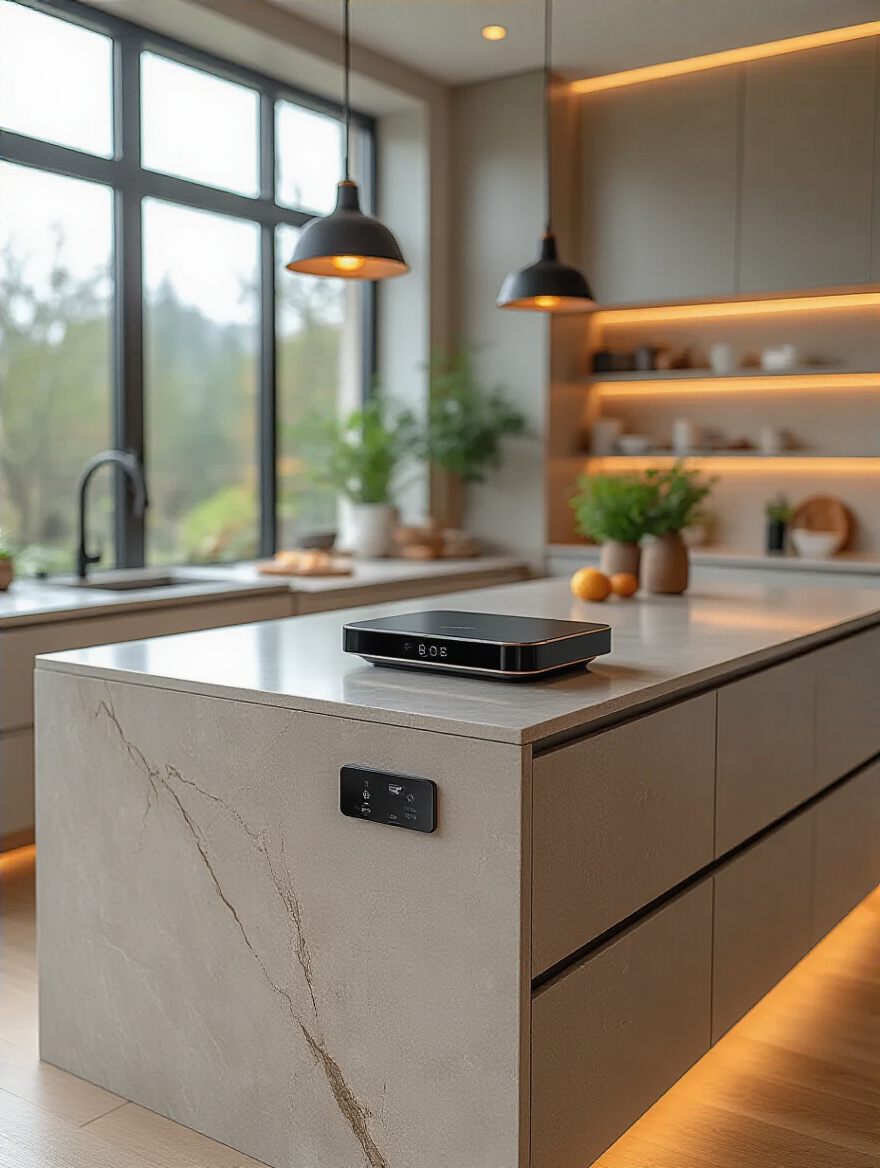
My favorite application of this is creating “scenes.” With one command like “Hey Google, start cooking,” you can have the lights over your prep area brighten, your favorite cooking playlist start, and the oven begin preheating. This isn’t about being lazy; it’s about removing friction and creating rituals that make daily tasks more seamless and enjoyable. The key is to start small with things that solve a real, specific problem for you, rather than just adding tech for tech’s sake.
Elevating Aesthetics: Lighting, Accents & Tech (Part 2)
We’re in the home stretch, focusing on the details that really bring a kitchen to life. These are the elements that layer in personality and make the space uniquely yours. It’s about choosing accents that are both functional and beautiful, serving your daily needs while also nourishing your soul.
15. Select Artful Bar Stools for Functional Seating and Style
Bar stools are more than just a place to sit; they are an invitation to connect. A well-placed set of stools at an island turns a solo cooking station into a social hub. This is where your kids can do their homework while you make dinner, where friends can gather with a glass of wine while you prep appetizers. This fosters the casual, everyday connection that is so crucial for family well-being.
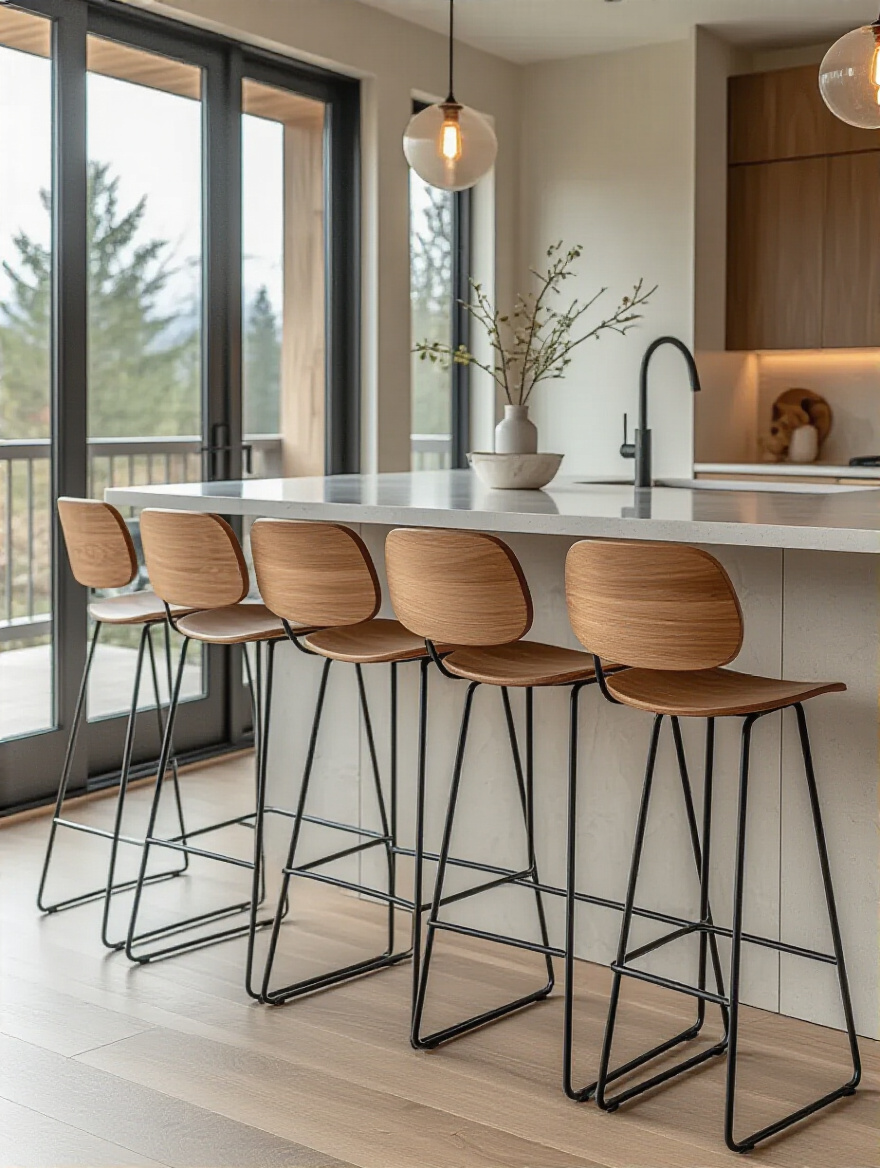
When choosing them, think ergonomics first. Are they comfortable? Is there a footrest? Does the height allow for enough leg room under the counter (you need about 10-12 inches)? After you’ve nailed the comfort, then you can focus on the style. This is a great place to introduce a new material—like warm wood, soft leather, or even a pop of color—to add a layer of texture and personality that softens the hard surfaces of the kitchen.
Now, let’s talk about the modern problem of our ubiquitous devices and how to manage them gracefully.
16. Implement Hidden Charging Stations for Devices
Nothing ruins a beautiful, calm countertop faster than a tangle of charging cords. It’s visual clutter at its worst. This is why planning for a hidden charging station from the beginning is a game-changer for mental clarity. The most common and effective solution is to dedicate one drawer as a charging drawer, outfitted with an approved in-drawer electrical outlet.
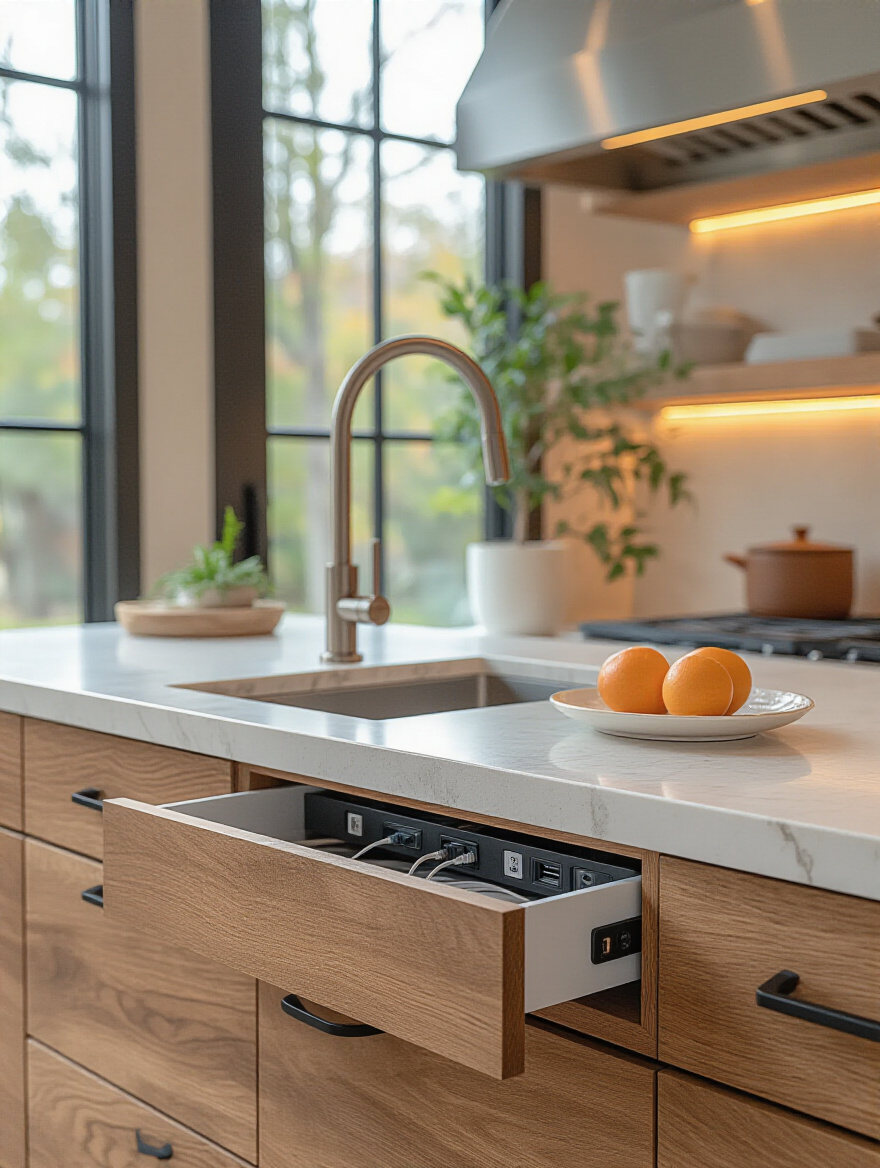
This creates a dedicated home for phones, tablets, and watches, getting them off your valuable prep space. More than that, it creates a gentle boundary. When devices are out of sight, you’re less tempted to constantly check them. This can help you be more present while cooking or eating, turning the kitchen into more of a mindful, tech-free zone. It’s a simple design choice that has a profound impact on how you interact with both your kitchen and your family.
Next, let’s bring a little bit of the outside in.
17. Introduce Greenery with Architecturally Pleasing Plants
This is one of the easiest and most powerful wellness hacks for any room, but especially the kitchen. Biophilic design—the practice of connecting people and nature within our built environments—has been proven to reduce stress, improve mood, and even boost creativity. Plants are the most direct way to do this. They literally clean the air by absorbing toxins and producing oxygen, and their organic shapes provide a beautiful, calming contrast to the clean lines of a contemporary kitchen.
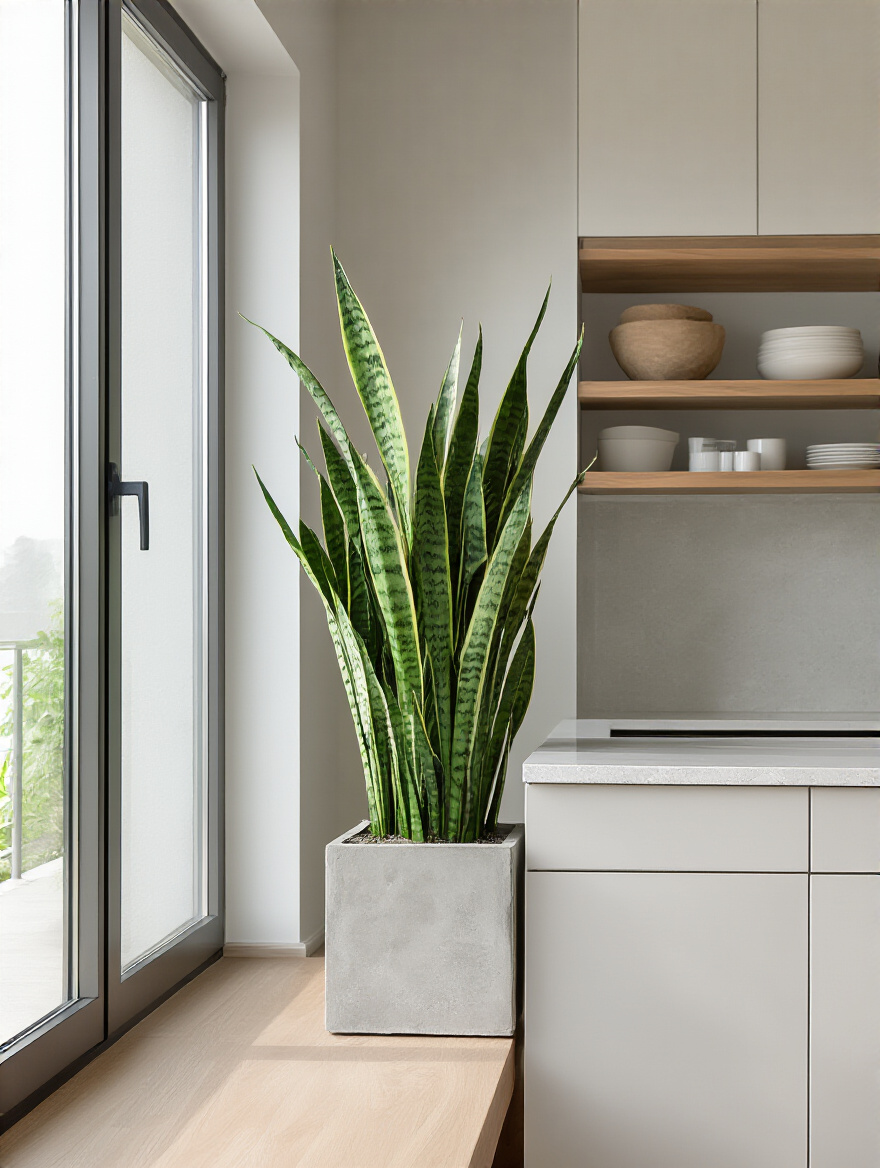
But don’t just grab any old fern. Choose plants with strong, sculptural forms that complement your aesthetic, like a tall, upright Snake Plant or the dramatic leaves of a Fiddle-Leaf Fig. And think beyond the windowsill. A small pot of fresh herbs not only looks and smells amazing but also provides fresh ingredients for your meals. A touch of green makes a space feel alive and cared for. It’s a signal to our brains that this is a healthy, nurturing place to be.
With that natural beauty in place, the other decor you bring in should be just as intentional.
18. Curate Minimalist Decor: Sculptural Bowls & Utensil Holders
Just like with minimalism, the goal of your decor isn’t an empty space, but a curated one. The noise isn’t in having objects; it’s in having meaningless objects. The shortcut is to make your functional items your decor. Instead of a generic ceramic crock for your utensils, find one from a local artist that you love the look and feel of. Instead of hiding your fruit, display it in a beautiful, sculptural wooden bowl that serves as a centerpiece.

This approach means everything you see has a purpose, which reinforces that sense of calm and intention. I learned this the hard way after accumulating a bunch of trendy but flimsy decor items that I quickly got sick of. Now, I tell clients to invest in one or two high-quality, artisan pieces that they will love for years. These items ground the space with a sense of craftsmanship and story, adding a layer of warmth and soul that mass-produced items never can.
Of course, all the beautiful decor in the world won’t feel good if what’s behind your cabinet doors is a total disaster.
19. Organize Drawers and Pantries for Clutter-Free Surfaces
This is the secret that underpins everything else. You cannot sustain a sleek, clutter-free kitchen without impeccable internal organization. A calm surface is the direct result of a well-organized interior. This is where you invest in smart dividers for your cutlery and utensil drawers, pull-out shelving for your pantry so you can see what’s in the back, and clear, uniform containers for dry goods.
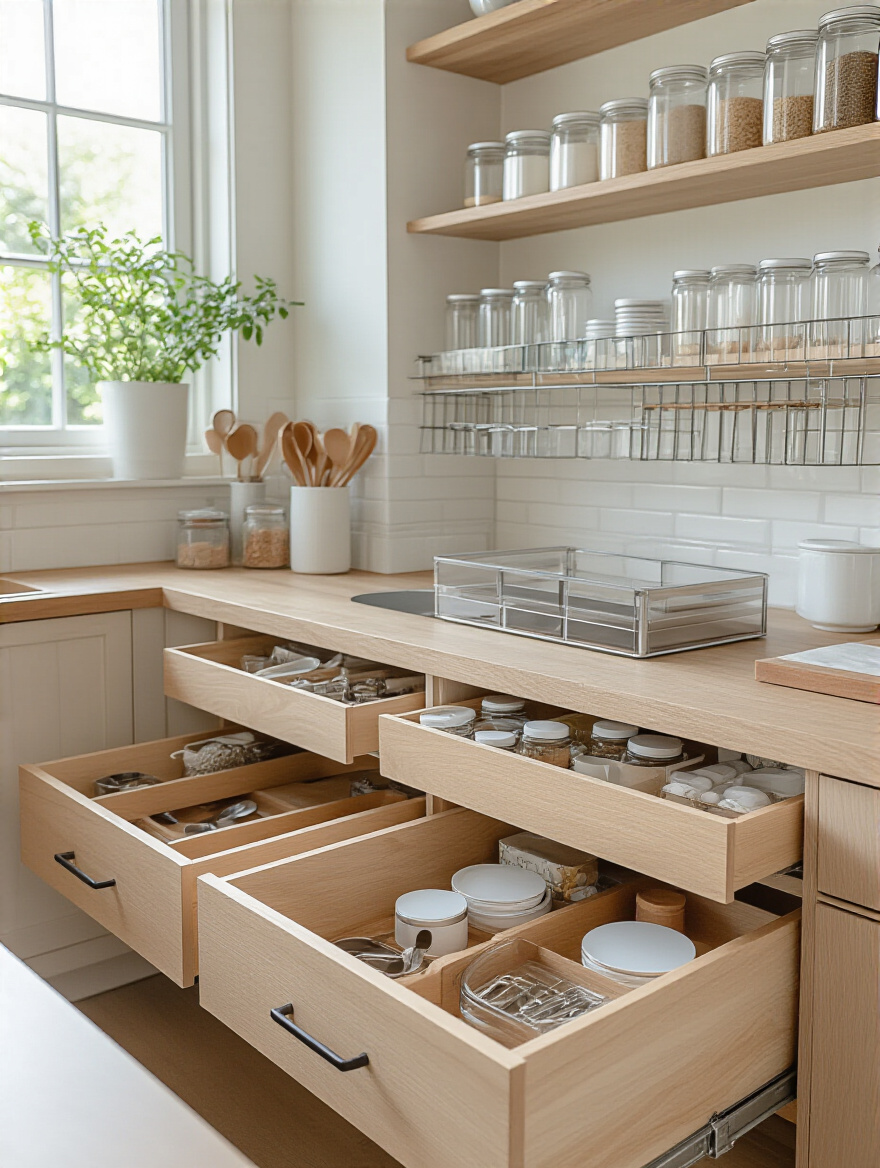
This isn’t just about being tidy; it’s about reducing daily friction. Think of the cumulative effect of a hundred tiny moments of frustration: not being able to find the lid for the pan, having an avalanche of spices every time you reach for the cumin. By creating a logical, intuitive system inside your cabinets and drawers, you create a hundred tiny moments of ease and calm. It is the most impactful and least visible upgrade you can make, and it will fundamentally change how you feel about using your kitchen.
Sustaining Sophistication: Organization & Personal Flourishes (Part 2)
We’ve arrived at the final, crucial step. A truly sophisticated design isn’t just about how a kitchen looks on day one; it’s about how it holds up to the reality of daily life. This is about making smart, forward-thinking choices that ensure your beautiful kitchen stays beautiful—and healthy—with minimal stress and effort.
20. Plan for Easy-Clean Surfaces to Maintain Sleekness
This might be the most important principle for long-term happiness with your kitchen. If a surface is difficult to clean, it will either cause you constant stress or it just won’t get cleaned properly, which undermines the healthy environment we’re trying to create. This concept should guide so many of your decisions. It’s why you choose flat-panel cabinets over detailed ones, non-porous quartz over porous marble, and large-format tiles to minimize grout.
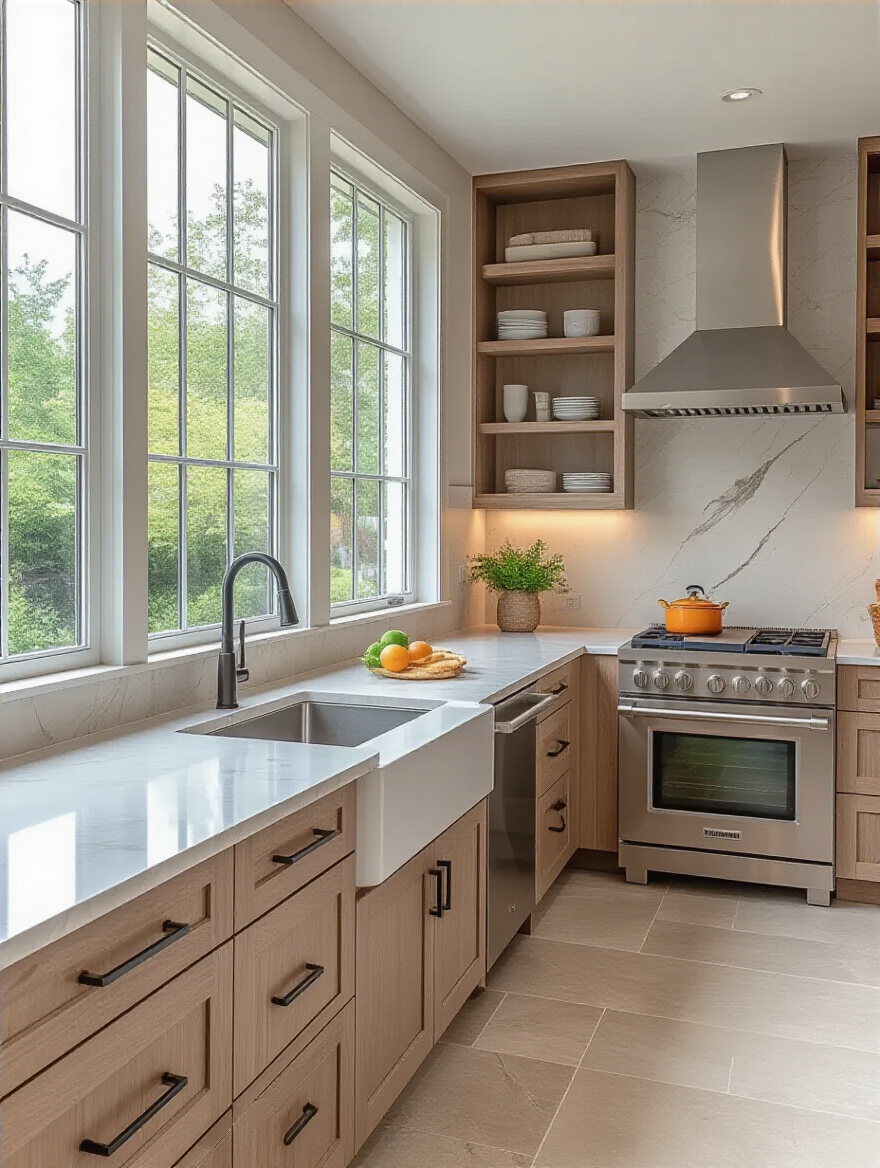
The ultimate pro tip is to create seamless transitions wherever possible. An undermount sink is a perfect example. It eliminates the raised lip of a top-mount sink where grime and gunk always collect. You can wipe crumbs directly from the counter into the sink with zero obstruction. Another is a continuous backsplash slab that runs from the counter all the way to the upper cabinets, eliminating grout lines entirely. Every time you eliminate a seam, a corner, or a crevice, you are designing a cleaner, healthier, and more serene space for your future self.
Conclusion
So, there you have it. The secret to a stunning contemporary kitchen isn’t found in a design magazine; it’s built on a foundation of well-being. It’s about seeing your kitchen not just as a place to cook, but as an ecosystem that can either drain you or support you. It starts with a layout that fosters connection and a lighting plan that honors your body’s natural rhythms. It’s built with materials that are hygienic, healthy, and easy to maintain, reducing both your chemical exposure and your stress levels. And it’s finished with intentional details that eliminate mental clutter and fill your space with beauty and joy.
When you start to see every design choice through this lens, the process becomes so much clearer. You’re not just picking a countertop; you’re choosing a surface that will support your family’s health for years to come. You’re not just organizing a drawer; you’re designing a small moment of calm in your busy day. This is how you create a kitchen that goes beyond “stunning” to become a true sanctuary—a space that nourishes you in every possible way. Your exceptionally healthy and beautiful contemporary kitchen is waiting.
